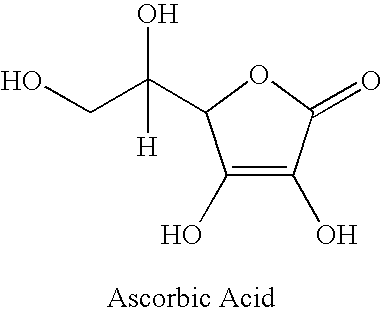Stable vitamin c compositions
- Summary
- Abstract
- Description
- Claims
- Application Information
AI Technical Summary
Benefits of technology
Problems solved by technology
Method used
Image
Examples
example 1
[0076] A non-limiting example of one embodiment of the present invention is exhibited in Table 1. The ingredients in Table 1 provide a stabilized vitamin C composition.
TABLE 1% ConcentrationIngredient(by weight)1.Vitamin C*9.132.Sesame oil46.739**3.Cyclomethicone26.994.Trihydroxystearin5.735.Hydrogenated polyisobutene5.4546.Caprylic / capric triglyceride3.67.Macadamia nut oil0.54548.Phytantriol0.0549.Tea tree oil0.05410.Tocopherol0.272711.Evening primrose oil0.05412.Spanish sage oil0.05413.Spanish rosemary oil0.05414.Coriander oil0.05415.Thyme oil0.05416.Pimento berries oil0.05417.Vitamin A palmitate0.5418.Methylparaben0.5419.Propylparaben0.02720.Beta carotene0.00054TOTAL100
*The vitamin C in this non-limiting embodiment is Ultra Fine Vitamin C powder. Add ingredients 2-20 one at a time in sequential order into a kitchenette planetary mixing equipment. Continuously mix while each ingredient is added. Subsequently, add vitamin C in small intervals and continue mixing. All mixing proce...
example 2
[0077] The composition described in Table 1 was stored at room temperature (approximately 70-75° F.) for approximately ten years. Subsequently, the composition was tested to determine the amount of stable vitamin C remaining in the composition. The testing procedure included dispersing the composition in methyl alcohol. Vitamin C was subsequently extracted from the sample with purified water. The stability of the vitamin C was calculated by an external standard method using reverse phase HPLC using a variable wavelength detector (a detailed description of the testing method used is provided in Example 3). The results are shown in Table 2.
TABLE 2% of Stable Vitamin CYearin the Composition09.13108.91
[0078] After approximately ten years of room temperature storage, 97.6% of stable vitamin C remained in the composition. Additionally, there was no significant discoloration in the aged composition.
example 3
Testing Vitamin C Stability
[0079] A non-limiting method that was used to test vitamin C stability in the composition in Table 1 is described in the following paragraphs.
[0080] Apparatuses Used: HPLC with variable wavelength UV detector and integrator (recommended settings include UV @ 255 nm, flow rate at 0.75 mL / min, sample size 5 μL, temperature at 35° C.); NH2 column, 5μ, 25 cm×4.6 mm (Whatman, Inc. catalogue #4691-3371); Analytical balance (read to 0.1 mg); Volumatric flasks (100 mL); Filtering discs (nylon 0.45μ); Vortex; Sonicator.
[0081] Reagents Used: Ascorbyl palmitate; Ascrobic acid; Methanol; Potassium Phosphate (monobasic); Phosphoric acid.
[0082] Calibration Standard Used: Weigh about 20 mg (.o2g) each of ascorbyl palmitate and ascorbic acid into a 100 mL volumetric flask. Add a sufficient amount of methanol to disperse the reagents and sonicate for about ten minutes. Fill up to 100 mL mark with methanol and mix. Prepare the calibration standard fresh.
[0083] Mobile P...
PUM
| Property | Measurement | Unit |
|---|---|---|
| Fraction | aaaaa | aaaaa |
| Fraction | aaaaa | aaaaa |
| Fraction | aaaaa | aaaaa |
Abstract
Description
Claims
Application Information
 Login to View More
Login to View More - R&D
- Intellectual Property
- Life Sciences
- Materials
- Tech Scout
- Unparalleled Data Quality
- Higher Quality Content
- 60% Fewer Hallucinations
Browse by: Latest US Patents, China's latest patents, Technical Efficacy Thesaurus, Application Domain, Technology Topic, Popular Technical Reports.
© 2025 PatSnap. All rights reserved.Legal|Privacy policy|Modern Slavery Act Transparency Statement|Sitemap|About US| Contact US: help@patsnap.com



